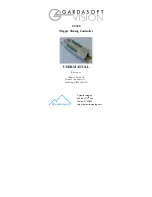
Evt<channel>,<tag>
where <channel> is the channel number from 1 to 8 and <tag> is a number from 0 to 255.
Multiple tag messages may be sent in one packet, separated by “;”.
6.2.3
Resync Flag (R)
Reject gate operation usually needs to be synchronised to the original product trigger. However
image processing can take a variable length of time to complete, so rejects based on when the
processing result is available cannot be accurately timed. The Resync flag allows pass/fail results
to be re-synchronised to the original trigger.
There are two types of reject gate:
•
A pulse is required to reject a product (set the P flag)
•
A pulse is required to stop a product being rejected (don’t set the P flag)
The Resync Flag should be used with the Ethernet Message flag. The host computer receives a
tag number message, processes the image and sends a pass/fail result (as an SN command) back
to the CC320. The CC320 matches the message to the original trigger and time the pass/fail
output pulse accurately.
If an SN command is not received in time, then the product is rejected, and an error code output.
6.2.4
FIFO Flag (F)
The FIFO flag is used for systems where there can be more than one product between the trigger
point and reject gate. This is usually used with the Resync flag, so that each product has its own
pass/fail result.
If the FIFO flag is not set, then an output cannot be re-triggered until the previous pulse has
completed. Others triggers in this time are ignored.
If the FIFO flag is set, then multiple triggers are stored in the CC320 and a pulse is generated for
each trigger at the correct time.
6.2.5
Pulse Flag (P)
The Pulse flag is used to select whether a pulse is needed to reject or to accept a product when
the Resync flag is set. When not set, a pulse is required to reject product. If a pass/fail message is
not received in Resync mode, the CC320 defaults to rejecting the product.
6.3
Examples
6.3.1
Sequenced Pulses
A sensor detects product presence. There are two cameras which need to take an image after
different delays. The leading edge of IP1 is used as the trigger. OP1 triggers the first camera after
100ms. OP2 triggers the second camera after 200ms. Both camera triggers are positive pulses.














































